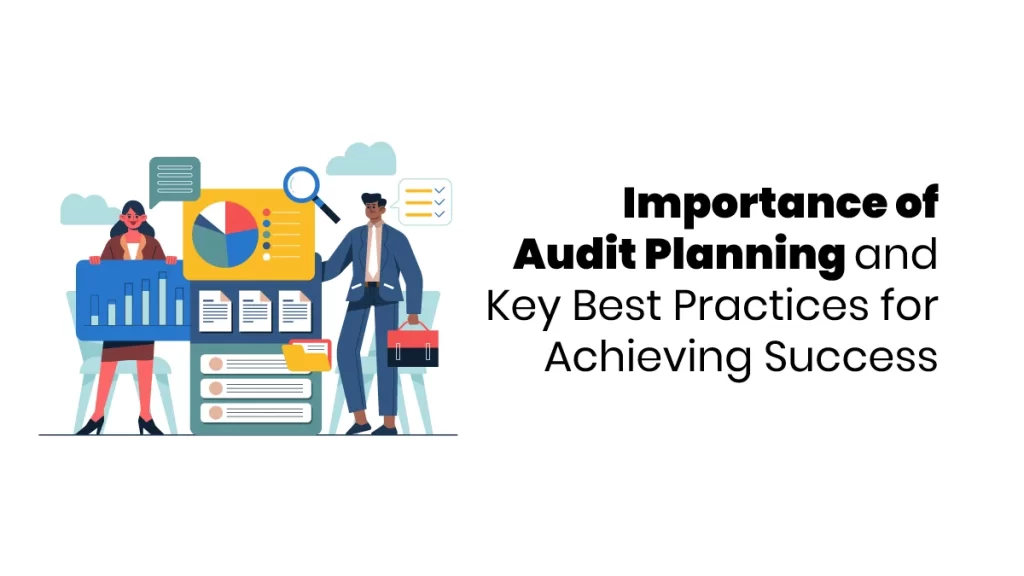The primary purpose of planning an audit is to set the overall strategy. This means creating a clear plan that specifies the necessary steps, timing, and resources. A well-prepared plan acts as a roadmap, guiding the audit team through the organization’s financial information and ensuring a comprehensive review before deeper analysis begins.
Main Parts of an Audit Plan
When setting up an audit plan, the auditor looks at a few main areas:
- Risk Check
The auditor checks for any risk areas that might need extra attention during the audit.
- Internal Control in Audit Planning
Internal control is important when planning an audit. Knowing how these controls work helps the auditor focus on the areas with higher risk and create an effective plan. The auditor learns about the client’s internal processes to identify areas needing closer examination.
- Keeping a Record of the Audit Plan
Writing down the audit plan is essential for a smooth audit process. This written plan guides the team through each step and is reviewed and updated as the audit goes on. The auditor reviews financial statements to find areas needing more detailed checking.
Steps in Audit Planning
Let’s read about steps in the audit planning process;
Initial Planning Phase
Audit planning begins at the start of the audit engagement. In this phase, the auditor creates an overall strategy that forms the basis for a detailed plan. This strategy includes the audit goals, timing, and needed resources.
Understanding the fundamentals of audit planning can be invaluable for those interested in finance courses. The auditor usually talks with the client and relevant regulatory bodies to ensure the plan matches the audit firm’s guidelines and the client’s needs.
Making the Audit Plan
Creating a detailed audit plan involves a few main steps:
- Understanding the Client: Knowing the client’s industry, business setup, and challenges helps the auditor make a plan that fits the client’s needs.
- Looking at Past Audits: Reviewing past audits can show areas that may need extra attention.
- Setting Clear Goals: Clear goals guide the audit team in what they need to check, such as ensuring rules are followed or that financial statements are accurate.
Parts of an Audit Plan
A good audit plan includes:
- Scope of the Audit: This defines what will and won’t be covered in the audit.
- Audit Tasks: These are the specific jobs the audit team will do.
- Audit Focus Areas: These are parts of the audit that need special attention, like inventory for a manufacturing company.
- Audit Timing: This schedules the audit work at times that cause the least disruption to the client’s business.
The Audit Approach
Risk-based planning focuses the audit on higher-risk areas. It adjusts the audit tasks to best manage these risks. This approach helps manage the audit better by ensuring resources are used where needed most.
Challenges in Audit Planning
Even with careful planning, auditors often face challenges that can affect the audit. Some of these challenges include:
- Changing Rules: New regulations or standards can come up during the audit, affecting the plan.
- Limited Resources: The audit team might need more resources to do the audit properly.
- Complex Client Business: Audit planning can be more complicated if the client’s business is complex.

Solutions for Effective Audit Planning
Here are some of the solutions for audit planning given below;
Handling Changing Rules
Auditors must stay updated on the latest regulations to plan effectively. This can be done through regular training and consulting with experts.
Managing Resources
Good planning helps auditors use resources effectively. This means picking the right team and ensuring they have the tools and technology needed for the audit.
Understanding the Client’s Business
Auditors should take time to understand the client’s business, industry, and risks. This helps them make a plan that covers all important areas.
Resource Optimization
Effective planning helps use resources wisely, making the audit more cost-effective and keeping the audit budget in check benefits both the audit firm and the client.
Compliance and Risk Management
A good audit plan helps ensure the audit follows all rules and standards. It also helps manage risks by focusing on high-risk areas and ensuring they are handled properly.
Audit planning is crucial for a smooth process. Setting clear goals, timelines, and resources improves accuracy and client trust. Learning best practices through accounting online courses builds essential skills for successful audits and financial reporting.










